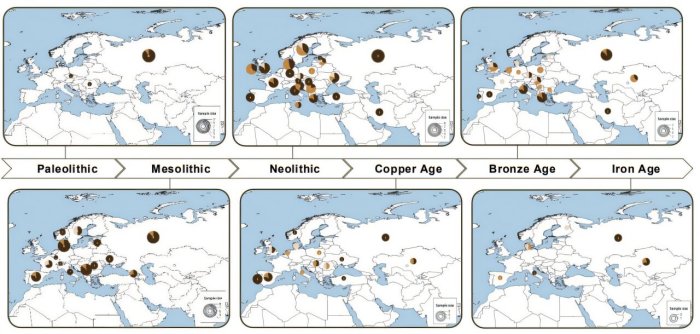Jan Bartek – AncientPages.com – Light eyes, hair, and skin are believed to have evolved multiple times as Homo sapiens moved out of Africa. In areas with lower UV radiation, lighter pigmentation alleles became more prevalent due to their adaptive advantages and influences, such as migration and genetic drift. However, the exact speed and process of this spread remain uncertain. Inferring phenotypes from ancient DNA is complex because these traits are polygenic and often involve low sequence depth.
Geographical distribution across Eurasia of selected ancient samples. The colored dots represent different time transect: black-Paleolithic, light blue-Iron Age, and intermediate shades-transitional periods (from Mesolithic to Bronze Age). The number of samples at each site is indicated inside each dot. The two test samples, the Paleolithic Ust’-Ishim and the Mesolithic SF12, are highlighted with labels. Credit: bioRxiv (2025). DOI: 10.1101/2025.01.29.635495
A recent study by researchers at the University of Ferrara in Italy explored the evolution of European skin, eye, and hair pigmentation over the last 45,000 years. The results suggest that lighter pigmentation traits developed gradually and in a non-linear fashion, with dark skin remaining common in many populations until well into the Copper and Iron Ages.
The researchers employed a probabilistic genotype likelihood method to deduce pigmentation traits from low-coverage ancient DNA samples, demonstrating a reliable and effective approach. This method is particularly compelling because it allows for accurate trait inference even with limited genetic data, making it an invaluable tool in the study of ancient populations. By leveraging this technique, we can gain deeper insights into our ancestral heritage with confidence and precision.
The study focused on two ancient genomes with high coverage: one from a 45,000-year-old Ust’-Ishim individual in Russia and another from a 9,000-year-old SF12 individual in Sweden. A downsampling experiment was conducted to simulate low-coverage conditions, allowing for the comparison of three genotype-calling methods: direct calling, imputation, and a probabilistic approach utilizing genotype likelihoods.
Light eye pigmentation is notably associated with the Mesolithic period, indicating that during this brief phase in human prehistory, it was more prevalent than in earlier Paleolithic or later Neolithic and Bronze Age periods. During the Neolithic era, 10,000 to 4,000 years ago there was an increase in pigmentation diversity as Anatolian farmers migrated into Europe. This migration led to a rise in lighter skin tones while darker phenotypes persisted, especially in Southern and Eastern Europe. Hair and eye color also varied, with red hair appearing occasionally in Turkey.
In the Copper and Bronze Ages,7,000 to 3,000 years ago, light pigmentation continued to increase; however, dark phenotypes remained widespread. By the Iron Age, 3,000 to 1,700 years ago, light skin became nearly as common as dark skin across Northern and Central Europe. Nonetheless, regions like Italy, Spain, and Russia still had prevalent dark pigmentation.
These changes were primarily driven by migration and gene flow rather than a straightforward selection process. The movement of Neolithic farming communities significantly influenced the distribution of pigmentation traits throughout Europe. Genetic studies have identified key variants such as SLC24A5 and TYR, among others, that contributed to these shifts.
Temporal and geographical distribution of skin pigmentation estimates in Eurasia from Paleolithic to Iron Age. The maps illustrate the spatial and temporal distribution of the inferred skin pigmentation phenotypes. Dimension of each pie chart indicates the sample size. Skin color results are grouped into three categories: Dark (Dark to Black and Dark), Intermediate, and Light (Pale and Very Pale). Credit: bioRxiv (2025). DOI: 10.1101/2025.01.29.635495
Overall findings indicate that light skin became widespread in Europe much later than previously believed and that these traits were shaped by a complex interaction of genetic factors and environmental influences over millennia.
“We could thus compare three approaches to pigmentation inference, concluding that, for suboptimal levels of coverage (
The shift towards lighter pigmentations turned out to be all but linear in time and place, and slower than expected, with half of the individuals showing dark or intermediate skin colors well into the Copper and Iron ages.
We also observed a peak of light eye pigmentation in Mesolithic times and an accelerated change during the spread of Neolithic farmers over Western Eurasia, although localized processes of gene flow and admixture, or lack thereof, also played a significant role!” the research team wrote in the study.
The study was published in bioRxiv
Written by Jan Bartek – AncientPages.com Staff Writer










